- There are no more items in your cart
- Shipping Calculated at checkout
- Sub-Total (inc. VAT) £0.00
Need Help?
Food Safe Paints
Specialist food-safe paints are essential coatings designed to comply with strict hygiene and safety standards for environments where food preparation, processing, or storage occurs. These paints are engineered to be non-toxic, easily cleanable, and resistant to bacteria, mould, and harsh cleaning agents. Ideal for commercial kitchens, food production facilities, and restaurants, food-safe paints offer a durable, protective layer that meets the rigorous requirements of food safety regulations. For optimal product compatibility and application, it's recommended to consult technical support.
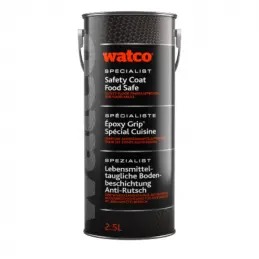
Watco Safety Coat Food Safe
A safety surface paint certified for use in food manufacturing and storage areas, with a fast-curing anti-slip coating.Meets requirements for EN14/3 (Food taint test) Excellent abrasion and UV resistance Can be applied at a temperature range of minus 10-30°CNote: While great care is taken with the colour samples shown, no guarantee...
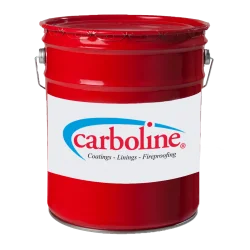
Carboline Plasite 7122
2-component, lining-grade epoxy which has wide chemical resistance and is suitable for use as a chemically resistant coating for aggressive atmospheric exposures or as a lining for a variety of chemical exposures.Versatile coating with wide chemical resistance. Excellent abrasion resistance. Excellent resistance to fuels. Final cure...
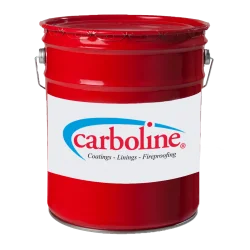
Carboline Plasite 7122 TFE
2-component, lining-grade epoxy which has wide chemical resistance and is suitable for use as a chemically resistant coating for aggressive atmospheric exposures or as a lining for a variety of chemical exposures. It is suitable for use in food-grade service where product purity (taste and odour) are critical.Versatile coating with wide...
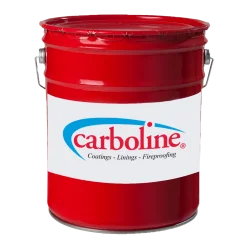
Carboline Plasite 9060
2-component, high solids modified epoxy cured with an amine adduct curing agent. Designed specifically as a highly chemical-resistant, non-toxic, tank lining.Excellent overall chemical resistance to a wide range of acids, alkalies and solvents. Particularly good abrasion resistance and flexibility. Surface will normally be tack-free in...
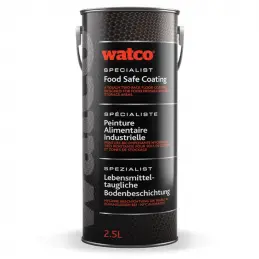
Watco Food Safe Floor Coating
A toughened two-pack floor coating designed for food preparation and storage areas and environments, including walk-in fridges.For use on concrete or sand and cement floors and asphaltProvided it is at least a month old and completely dryCan be used on most existing coatings, wood, metals and fibreglass although a sample area...
Need Help?
Need Help?
In various industries, from hospitality to food manufacturing, using food-safe paints is not just a recommendation but a necessity. These coatings protect surfaces from bacteria, mould, and fungi while also providing a washable and durable finish that can endure the rigorous demands of food handling and preparation. Whether in a commercial kitchen, a food processing plant, or a bakery, food-safe paints help to uphold the highest standards of cleanliness and safety.
Certification and Compliance
Certification and compliance are crucial aspects of selecting and using food-safe paints. These paints must meet specific regulatory standards to ensure they are safe for use in environments where food is present. Compliance with these standards not only protects public health but also ensures that businesses operate within the legal frameworks set by food safety authorities.
HACCP Compliance
Hazard Analysis and Critical Control Points (HACCP) is an internationally recognized system for reducing the risk of safety hazards in food production. Food-safe paints that are HACCP-compliant are specifically formulated to minimize the risk of contamination, making them suitable for use in critical areas where food is handled.
EFSA and FSA Standards
The European Food Safety Authority (EFSA) and the UK’s Food Standards Agency (FSA) provide guidelines and regulations for food safety. Food-safe paints that meet these standards are certified to be non-toxic and safe for use in food-related environments. Compliance with EFSA and FSA standards ensures that the paint will not release harmful substances that could contaminate food.
BRC Global Standards
The British Retail Consortium (BRC) Global Standards are a leading safety and quality certification program, used by over 26,000 certified suppliers in 130 countries. Food-safe paints that meet BRC standards ensure that products meet high levels of safety and quality required by food industry leaders.
ISO 22000 Certification
This standard specifies requirements for a food safety management system. Food-safe paints that comply with ISO 22000 are part of a broader food safety strategy that ensures safe handling, preparation, and storage of food products.
NSF Certification
The National Sanitation Foundation (NSF) certifies products that meet strict public health and safety standards. Food-safe paints with NSF certification are recognized for their safety and effectiveness in food environments, providing an additional level of assurance for businesses and consumers.
Ensuring that food-safe paints have the appropriate certifications and comply with relevant standards is essential for maintaining a safe and legally compliant environment. Businesses should always verify the certifications of any food-safe paint they intend to use.
Top Benefits of Food-Safe Paints
Enhanced Hygiene
Food-safe paints are specifically formulated to create smooth, non-porous surfaces that do not absorb contaminants. These surfaces are significantly easier to clean and disinfect, which is vital in food-related environments where hygiene is paramount. By preventing the build-up of bacteria and mould, food-safe paints help maintain a higher standard of cleanliness, reducing the risk of foodborne illnesses and ensuring that businesses can meet stringent hygiene standards.
Compliance with Food Safety Regulations
Using paints that comply with food safety regulations ensures that businesses can meet their legal obligations. Regulatory bodies such as the European Food Safety Authority (EFSA) and the Food Standards Agency (FSA) in the UK set strict standards for food-related environments. By using compliant paints, businesses can avoid potential legal repercussions, such as fines or closures, while also providing assurance to customers that their operations are safe and hygienic.
Increased Durability
Food-safe paints are engineered to withstand the harsh conditions of food environments, including frequent exposure to cleaning agents, high and low temperatures, and heavy wear. This durability reduces the need for frequent repainting, minimizing disruption to operations and lowering maintenance costs. Durable paints also ensure that surfaces remain intact and effective over time, providing consistent protection against contaminants.
Antimicrobial Protection
The inclusion of antimicrobial agents in food-safe paints provides an added layer of protection against bacterial and fungal growth. In environments where moisture and food particles can create ideal conditions for microbes, these paints actively inhibit the growth of harmful bacteria and mould, contributing to a safer environment for food preparation and processing. This is particularly important in preventing cross-contamination and ensuring that food products remain safe for consumption.
Versatility Across Surfaces
Food-safe paints are versatile enough to be used on a wide range of surfaces, including walls, ceilings, floors, and equipment. This allows businesses to apply a consistent protective coating throughout their facilities, ensuring that all areas where food is handled or stored are compliant with hygiene standards. Whether used in a commercial kitchen, a processing plant, or a storage facility, these paints offer comprehensive protection across the entire environment.
Temperature and Humidity Resistance
The ability of food-safe paints to withstand extreme temperatures and high humidity is crucial in many food-related environments. In kitchens, for example, surfaces are exposed to high heat from ovens and stoves, while in cold storage areas, they must endure low temperatures. Food-safe paints are designed to maintain their integrity in these conditions, ensuring that they do not crack, blister, or degrade, which could compromise the safety of the food being prepared or stored.
Improved Safety with Slip-Resistant Flooring
In environments where spills, moisture, or grease are common, slip-resistant food-safe paints for floors help prevent accidents. These paints are designed to provide traction underfoot, reducing the risk of slips and falls that could lead to injury. By enhancing workplace safety, these paints contribute to a safer and more efficient working environment, particularly in busy kitchens and food processing facilities where the risk of accidents is higher.
Odour Control for Sensitive Environments
Low-odour or odourless formulations are essential in food-related environments where strong smells could affect food quality or create an unpleasant atmosphere. Food-safe paints that minimize odour ensure that the application process does not disrupt ongoing operations or negatively impact the products being prepared. This is particularly important in environments where food is produced or stored, as even slight odours can permeate food products.
Eco-Friendly Solutions
As businesses increasingly prioritize sustainability, eco-friendly food-safe paints offer a way to reduce environmental impact while maintaining high safety standards. Low-VOC formulations minimize the release of harmful chemicals into the air, making these paints safer for both workers and the environment. By choosing environmentally friendly options, businesses can align their operations with sustainability goals and demonstrate their commitment to protecting the planet.
Longevity of Appearance
Food-safe paints are designed to retain their colour and finish over time, even in harsh environments. This means that surfaces coated with these paints will continue to look clean and professional, contributing to a positive image for the business. In customer-facing areas, such as open kitchens or dining rooms, maintaining a fresh and appealing appearance is important for customer satisfaction and trust.
Types of Food-Safe Paints
Food-safe paints come in various formulations, each designed to meet specific needs in different food-related environments. Understanding the types of food-safe paints available can help in selecting the right product for your facility:
Epoxy Paints
Epoxy-based food-safe paints are highly durable and resistant to chemicals, making them ideal for use in environments where surfaces are frequently exposed to cleaning agents or corrosive substances. These paints create a hard, non-porous finish that is easy to clean and maintain, making them suitable for walls, floors, and equipment in food processing plants, commercial kitchens, and breweries.
Polyurethane Paints
Polyurethane food-safe paints offer excellent resistance to abrasion and are highly flexible, which makes them ideal for surfaces that experience significant wear and tear. These paints are also resistant to moisture and can withstand extreme temperature fluctuations, making them suitable for use in cold storage facilities, dairies, and bakeries.
Acrylic Paints
Acrylic food-safe paints are water-based and offer a low-VOC option for environments where environmental impact is a concern. These paints are easy to apply, quick-drying, and provide a durable finish that is resistant to staining and microbial growth. Acrylic paints are often used in hospitality settings, schools, and supermarkets where aesthetic appeal is also important.
Silicone Paints
Silicone-based food-safe paints are known for their high heat resistance, making them ideal for use in environments where surfaces are exposed to extreme temperatures, such as near ovens or in industrial kitchens. These paints are also highly resistant to moisture, making them suitable for use in damp environments like fish processing plants or cold storage facilities.
Zinc-Rich Paints
Zinc-rich food-safe paints are typically used as primers or undercoats in environments where corrosion resistance is critical. These paints are often used on metal surfaces, such as equipment and storage tanks, in dairies, breweries, and other facilities where exposure to moisture and acidic substances is common.
Selecting the right type of food-safe paint depends on the specific needs of the environment, including the types of surfaces being coated, the conditions they will be exposed to, and the regulatory requirements that must be met.
Common Uses for Food-Safe Paints
Specialist food-safe paints are essential in a variety of settings where food safety is a priority. Below are detailed descriptions of how these paints are used across different types of buildings, properties, and businesses:
Commercial Kitchens
In commercial kitchens, food-safe paints are used on walls, ceilings, and floors to ensure compliance with strict hygiene standards. These kitchens are often high-traffic areas where surfaces are exposed to heat, moisture, and frequent cleaning. Food-safe paints provide a durable, non-porous finish that resists stains and can be easily cleaned, reducing the risk of bacterial growth. In addition, slip-resistant paints are commonly used on floors to prevent accidents in environments where spills and grease are common.
Food Processing Plants
Food processing plants require high levels of cleanliness and sanitation to prevent contamination during the production process. Food-safe paints are used on machinery, production lines, walls, and floors to create surfaces that are easy to clean and resistant to microbial growth. These paints must also withstand exposure to cleaning chemicals and varying temperatures. In environments where food is processed on a large scale, the use of food-safe paints is critical to maintaining compliance with food safety regulations and ensuring the safety of the final product.
Bakeries
Bakeries are unique environments that often experience high humidity and fluctuating temperatures. Food-safe paints used in bakeries must be resistant to these conditions while providing a protective barrier against mould and bacteria. These paints are applied to walls, ceilings, and equipment to create surfaces that are easy to clean and maintain. The durability of food-safe paints is particularly important in bakeries, where flour, sugar, and other ingredients can create a challenging environment for maintaining cleanliness.
Dairies and Breweries
In dairies and breweries, food-safe paints are essential for protecting surfaces from the acidic nature of dairy products and brewing processes. These environments often involve exposure to moisture, temperature fluctuations, and chemical cleaning agents. Food-safe paints used in these settings must be resistant to these conditions to prevent deterioration and contamination. In addition to walls and ceilings, these paints are often used on equipment and storage tanks to ensure that all surfaces in contact with food products remain safe and compliant with hygiene standards.
Cold Storage Facilities
Cold storage facilities play a critical role in preserving the freshness and safety of food products. In these environments, food-safe paints are used on walls, ceilings, and floors to prevent condensation and mould growth. The paints must be able to withstand low temperatures without cracking or peeling, ensuring that the protective barrier remains intact. In cold storage areas where temperature control is crucial, food-safe paints help maintain the integrity of the facility and protect the quality of the stored products.
Butcheries and Meat Processing Plants
Butcheries and meat processing plants require high levels of cleanliness to prevent contamination from blood, fat, and other organic materials. Food-safe paints used in these environments must be resistant to staining and easy to clean. These paints are applied to walls, floors, and equipment to create surfaces that can withstand exposure to harsh cleaning agents and frequent washing. In addition to preventing contamination, food-safe paints in these settings help create a safe and sanitary environment for workers.
Fish Processing Plants
Fish processing plants present unique challenges due to the corrosive effects of saltwater and fish oils. Food-safe paints used in these environments must be highly resistant to corrosion and capable of withstanding exposure to moisture. These paints are typically applied to walls, ceilings, and equipment to protect against rust and bacterial growth. The durability of food-safe paints in fish processing plants is essential to maintaining hygiene standards and ensuring the safety of the final product.
Hospitality Settings
In hotels, resorts, and event venues, food-safe paints are used in kitchens, dining areas, and food storage rooms to ensure that all food-related environments meet health and safety standards. These paints contribute to a professional appearance while ensuring that surfaces are safe for food contact. In addition to providing a durable and hygienic surface, food-safe paints in hospitality settings help create an inviting atmosphere for guests, which is essential for maintaining a positive reputation.
Schools and Educational Facilities
School kitchens and cafeterias require food-safe paints to ensure that all surfaces where food is prepared and served are hygienic. These paints help create a safe environment for students and staff by resisting bacterial growth and facilitating easy cleaning. In addition to kitchens and dining areas, food-safe paints are often used in food storage areas to protect against contamination. Ensuring that these environments are safe and compliant with food safety standards is critical to the health and well-being of students.
Supermarkets and Food Retail Stores
In supermarkets, food-safe paints are used on walls, floors, and shelving in areas where fresh produce, meat, and other perishables are displayed. These paints ensure that the environment remains hygienic and that surfaces are resistant to spills and stains from food products. In addition to maintaining cleanliness, food-safe paints in supermarkets help create a visually appealing shopping experience for customers. The use of food-safe paints in these settings is essential for ensuring the safety and quality of the products being sold.
Pharmaceutical and Nutraceutical Production
Although not directly related to food, pharmaceutical and nutraceutical facilities often require food-safe paints to ensure that their production environments meet stringent hygiene standards. These paints help prevent contamination in environments where products are ingested. Food-safe paints used in these facilities must be resistant to chemical exposure and capable of maintaining their protective qualities over time. In addition to ensuring product safety, the use of food-safe paints in these settings helps companies comply with industry regulations and standards.
Animal Feed Production Facilities
In facilities where animal feed is produced, food-safe paints ensure that all surfaces are non-toxic and resistant to bacterial growth. These paints help maintain a clean environment, preventing contamination of the feed. In addition to protecting the health of the animals, food-safe paints in these settings help ensure that the feed meets regulatory standards. The use of food-safe paints in animal feed production facilities is critical for maintaining the safety and quality of the products being produced.
FAQs
What is food-safe paint?
Food-safe paint is a type of coating specifically formulated to be safe for use in environments where food is prepared, processed, or stored. These paints are non-toxic, resistant to microbial growth, and compliant with food safety regulations, ensuring that they do not contaminate food products or compromise hygiene.
Are food-safe paints resistant to cleaning chemicals?
Yes, food-safe paints are designed to be highly resistant to cleaning chemicals and disinfectants. They are formulated to withstand frequent washing and sanitizing without deteriorating or losing their protective properties.
Do food-safe paints have antimicrobial properties?
Many food-safe paints include antimicrobial agents that help inhibit the growth of bacteria, mould, and fungi. This is especially important in environments where hygiene is critical, as it helps prevent contamination and ensures a safer environment for food handling.
How do I know if a paint is food-safe?
To ensure that a paint is food-safe, look for certifications from regulatory bodies such as the European Food Safety Authority (EFSA) or the Food Standards Agency (FSA) in the UK. The paint should also be labeled as non-toxic, and it is important to check for any specific certifications related to food safety, such as HACCP compliance. If you are unsure, contact Rawlins’ Technical Team to chat with our experts about your project requirements for suitable products.
How long do food-safe paints last?
The longevity of food-safe paints depends on the specific environment in which they are used and the conditions they are exposed to. However, these paints are generally designed to be highly durable, resisting wear, chemical exposure, and temperature fluctuations to provide long-lasting protection.
How should food-safe paint be applied?
Food-safe paint should be applied according to the manufacturer's instructions, typically using standard painting equipment such as brushes, rollers, or sprayers. Proper surface preparation is essential to ensure good adhesion and durability, and it is important to allow sufficient drying and curing time before the area is put back into use. For best results, consult with technical support to ensure that the correct products and application methods are used.
